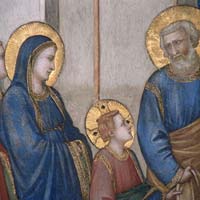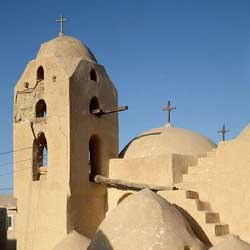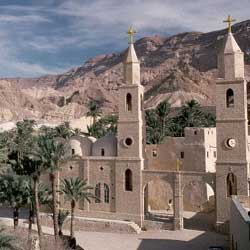|
The Foundations of
Monasticism
Egypt is regarded by many Christians, regardless of
denomination, as the home of Christian monasticism, and it is
very easy to see why. The sheer number of Christian monasteries
scattered about the East is astounding, from the 300 that were
in Constantinople alone to the isolated Saint Catherine's at
Mount Sinai. Yet it was Egypt that was seen as the heart of the
monastic idea.
Christian monasticism emerged as a genuine movement during the
early fourth century, but the spirit of monasticism was already
present in Christianity with its ideas of asceticism and
moderation. For the Christian East, the monk was by definition a
solitary role, and there have been more Christian hermits in
this area than in any other in the world.
 It is Saint Anthony of Egypt who is credited with the founding
of monasticism, along with his fellow countryman Saint Pachomius.
Yet even they were only expanding on an idea that had already
existed. Yet Anthony still deserves the praise due to him, for
his true innovation was to move the monastic community away from
the distractions of society and the city and into the
wilderness, which he did, founding his first hermitage in AD
305. It is Saint Anthony of Egypt who is credited with the founding
of monasticism, along with his fellow countryman Saint Pachomius.
Yet even they were only expanding on an idea that had already
existed. Yet Anthony still deserves the praise due to him, for
his true innovation was to move the monastic community away from
the distractions of society and the city and into the
wilderness, which he did, founding his first hermitage in AD
305.
Unlike monasteries in the West, the monasteries of Egypt and the
surrounding area had no centralized orders, rather, each one was
an autonomous unit. Many of the early monasteries in the East
were founded and maintained by the rulers and nobility, others
by groups of the citizenry wishing to have prayers said for
themselves and their families. The size of the monasteries also
varied greatly. Some were highly organized enterprises, owning
large amounts of land and commercial interests, while others
were hermitages of only three or four members. After Saint
Anthony, there were two basic types of monasticism in Egypt, and
later on, the world. There was the eremetical, or hermit, style
and the cenobitic, monasteries in which the residents led a
communal life.
These Egyptian ascetics each lived very similar lives to the
others of their type. They took vows of chastity and poverty,
and if part of a monastic community, obedience to the abbot.
They practiced long and frequent fasts, some abstained from
alcohol and meat, and they supported themselves by doing
services for the lay people nearby, such as helping with labor
or the selling of some small handicrafts. The largest
monasteries were often self-sufficient, owning farms and herds,
as well as making everything they needed, from the clothes they
wore to the bread that was on their table. If they did make any
money for anything they did, they kept only what they needed to
subsist and gave the rest to the poor. While crowds of the poor
often joined monasteries (vows of poverty being nothing new to
them, and at least they would have food, clothing, and shelter),
later on many of the upper class joined as Christianity spread
across class and caste. Quite a number of the latter were
educated and were employed by the Church in various intellectual
occupations such as catechists, clerks and doctors. From the
very beginning, the early Christian Church had a place and a
task for everyone.
St Catherine
Monastery and Mount Sinai
 Venerated by Christians, Jews and Muslims as the site of the
God’s revelation of the Ten Commandments, Mount Sinai, 5012 feet
high above sea level , overlooks the valley where Moses have
heard the Lord speaking from a burning bush. Venerated by Christians, Jews and Muslims as the site of the
God’s revelation of the Ten Commandments, Mount Sinai, 5012 feet
high above sea level , overlooks the valley where Moses have
heard the Lord speaking from a burning bush.
The bush is now enshrined in St Catherine’s Monastery, nestling
in a valley at the foot of the Mount, surrounded by high walls
and lush gardens.
The visitors are keen on climbing the mountain to watch sunrise.
The Monastery of St Catherine is a Greek Orthodox foundation.
Its origins date back to 337 AD, when the Byzantine Empress
Helena ordered the construction of a chapel around the putative
Burning Bush, already a focus for hermits and pilgrimages.
The monastery was named after St Catherine “the daughter of
Kistery” who has tortured to death by her father for she
succeeded in converting 50 of his followers to Christianity in
307 AD.
We enter through a small gate in the northern wall near Kleber's
Tower (named after Napoleonic general who ordered its
reconstruction) rather than the main portal facing west, which
has a funnel for pouring boiling oil onto attackers. Built of
granite, 10-15m high and 2-3m thick, St Catherine's walls are
essentially unchanged since Stephanos Ailisios designed them in
the sixth century.
Emerging from the passage, a right turn takes us past Moses's
Well, where the then-fugitive from Egypt met Zipporah, one of
Jethro's seven daughters, whom he married at the age of forty.
Walking the other way and around the corner, you will see a
thorny evergreen bush outgrowing an enclosure. This is the
transplanted descendant of the Burning Bush Whence God Spoke to
Moses: "Come now therefore, and I will send thee unto Pharaoh,
that thou mayest bring forth my people the children of Israel
out of Egypt" (Exodus 3:10) . Sceptics may be swayed by the news
that it's the only bush of its kind in the entire peninsula, and
that all attempts to grow cuttings from it elsewhere have
failed. The Bush was moved to its present site when Helena's
chapel was built over its roots, behind the apse of the Church
of St Catherine.
A granite basilica, St Catherine's Church was erected by
Justinian between 542 and 551; the walls and pillars –
representing the months of the year and hung with icons of the
saints venerated during each one – have ornately carved
capitals, loaded with symbolism. At the far end, a lavishly
carved and gilded iconostasis rises towards a superb mosaic
depicting Jesus flanked by Moses and Elijah, with Peter, John
and James kneeling below – unfortunately it's roped off and hard
to see behind the ornate chandeliers and censers suspended from
the coffered, eighteenth – century ceiling. Behind the
iconostasis is the Chapel of the Burning Bush, only viewable by
special dispensation. The narthex displays a selection of the
monastery's vast collection of icons, running the gamut of
Byzantine styles and techniques, from encaustic wax to tempera.
The church's bell is rung 33 times to rouse the monks before
dawn.
Other parts of the monastery are often closed to laypersons.
Amongst them are an eleventh – century mosque, added to placate
Muslim rulers; a library of over 3000 manuscripts and 5000 books
in various languages , surpassed only by the Vatican's; and a
refectory with Gothic arches and Byzantine murals.
The monastery of
Saint Anthony
 Saint Anthony is often called "the Father of the Monks". He is
credited with the founding of Christian monasticism, and many of
his ideas are still used to this day by modern monks and nuns.
Most of what we know about Anthony comes from the writings of
Saint Athanasius the Apostolic, a disciple and close friend of
Anthony's. Anthony was born about AD 251 and was the son of a
well-to-do family from middle Egypt. When he was eighteen his
parents died, leaving him sole guardian of his younger sister
Dious. Six months later, while attending a church, he heard the
scripture passage of Jesus and the rich young man, in which
Jesus says, "If you would be perfect, go, sell all you have,
give to the poor, and follow me (Matt. 19:21)." He took this as
a personal invitation from God and sold most of his inherited
property, gave much of the money to the poor and the rest to his
sister and placed his sister in the care of a community of holy
women. He sought guidance from a holy man near Coma in the ways
of the Christian ascetic: prayer, fasting, and holiness. After a time of study,
Saint Anthony left on his own and began living in the manner of
a mountain hermit, living in a cave and praying for the
salvation of the world. At the age of thirty-five, he moved to
Pispir and remained there in solitude for twenty years. During
that time, many came to live near him and copy his holy life. He
became their spiritual leader, teaching them by word and by
example the life of the ascetic. Anthony also taught them to
perform manual labor between prayer times as an additional
contribution to society. Saint Anthony is often called "the Father of the Monks". He is
credited with the founding of Christian monasticism, and many of
his ideas are still used to this day by modern monks and nuns.
Most of what we know about Anthony comes from the writings of
Saint Athanasius the Apostolic, a disciple and close friend of
Anthony's. Anthony was born about AD 251 and was the son of a
well-to-do family from middle Egypt. When he was eighteen his
parents died, leaving him sole guardian of his younger sister
Dious. Six months later, while attending a church, he heard the
scripture passage of Jesus and the rich young man, in which
Jesus says, "If you would be perfect, go, sell all you have,
give to the poor, and follow me (Matt. 19:21)." He took this as
a personal invitation from God and sold most of his inherited
property, gave much of the money to the poor and the rest to his
sister and placed his sister in the care of a community of holy
women. He sought guidance from a holy man near Coma in the ways
of the Christian ascetic: prayer, fasting, and holiness. After a time of study,
Saint Anthony left on his own and began living in the manner of
a mountain hermit, living in a cave and praying for the
salvation of the world. At the age of thirty-five, he moved to
Pispir and remained there in solitude for twenty years. During
that time, many came to live near him and copy his holy life. He
became their spiritual leader, teaching them by word and by
example the life of the ascetic. Anthony also taught them to
perform manual labor between prayer times as an additional
contribution to society.
When the persecutions began again against the Christians in
Egypt at the hands of Maximinus Daia in the early 300s, he went
to Alexandria and ministered to those in prison. After the
persecutions ended, he returned to his life of solitude. He
returned to Alexandria once more to support Pope Athanasius
against the Arian Heresy in 352, and many came to see the aged
holy man as he walked through the city, but he returned to his
desert soon after, society no longer having any hold on him.
Contrary to popular belief, Anthony founded no formal monastery
and his Rule was simply work and prayer. Anthony also designed
the first monastic uniform, an all-purpose robe of white linen
fastened about the waist with a sturdy leather belt. This has
become the basic pattern for monastic garb all over the world
and in all times since. Many came to Saint Anthony for advice,
spiritual help, and healing. Saint Anthony died in 356 at the
age of one hundred and five and was buried secretly by Macarius
and Amatas, two of his most loyal monks.
St. Anthony's Monastery (Deir Mar Antonios), and its neighbor
St. Paul's, are the oldest monasteries founded in the Egyptian
desert . Hidden deep in the Red Sea Mountains and relying on
springs for their water supply, both still observe rituals that
have hardly changed in 16 centuries.
St. Anthony's was founded in 356 AD, just after the saints
death. Between the 12th and 15th centuries, the monastery
flourished but was plundered in 1454 by Bedouin servants. Today
it is a self-contained village with gardens, a mill, a bakery
and five churches with exceptional wall paintings of holy
knights in3 bright colors and the hermit founders of the
monastery in subdued colors and icons. There is also a library
with over 1,700 handwritten manuscripts, but the Bedouin
servants who plundered the monastery used many manuscripts for
cooking fuel. At one time, there must have been a much more
extensive library. St. Anthony's Cave (magharah), where he lived
as a hermit, is a 2 km hike from the monastery and 680 m. above
the Red Sea. It offers stunning views of the mountains and the
sea, and the chance to see a wide range of bird life.
The monastery of
Saint Paul
 The monastery of St Paul has always been overshadowed by St
Anthony’s. Its titular founder was only sixteen when he fled
Alexandria to escape Emperor Decius’s persecutions, making him
the earliest known hermit. Shortly before his death in 348, Paul
was visited by Anthony and begged him to bring the rope of Pope
Athanasius, for Paul to be buried in. Anthony departed to fetch
this, but on the way back had a vision of Paul’s soul being
carried up to heaven by angels and arrived to find him dead.
While Anthony was wondering what to do, two lions appeared and
dug a cave for the body, so Anthony shrouded it in the robe and
took Paul’s tunic of palm leaves as a gift for the pope, who
subsequently wore it at Christmas, Epiphany and Easter. The monastery of St Paul has always been overshadowed by St
Anthony’s. Its titular founder was only sixteen when he fled
Alexandria to escape Emperor Decius’s persecutions, making him
the earliest known hermit. Shortly before his death in 348, Paul
was visited by Anthony and begged him to bring the rope of Pope
Athanasius, for Paul to be buried in. Anthony departed to fetch
this, but on the way back had a vision of Paul’s soul being
carried up to heaven by angels and arrived to find him dead.
While Anthony was wondering what to do, two lions appeared and
dug a cave for the body, so Anthony shrouded it in the robe and
took Paul’s tunic of palm leaves as a gift for the pope, who
subsequently wore it at Christmas, Epiphany and Easter.
The monastery, called also Deir Anba Bula , was a form of
posthumous homage by Paul’s followers: its turreted walls are
built around the cave where he lived for decades. To a large
extent, its fortunes have followed those of its more prestigious
neighbour. In 1484 all its monks were slain by the Bedouin, who
occupied St Paul’s for eighty years, rebuilt by Patriarch
Gabriel VII, it was again destroyed near the end of the
sixteenth century.
The monastery is smaller than that of St Anthony and a little
more primitive-looking. In its main church of St Paul, the
murals, too, are less fluid – though better preserved. The
southern sanctuary of the larger Church of St Michael contains a
gilded icon of the head of John the Baptist on a dish. When
Bedouin raided the monastery, its monks retreated into the
five-storey keep, supplied with spring water by a hidden canal.
Nowadays this is not enough to sustain the seventy-old monks and
their guests, so water is brought in from outside.
Popular Christianity Places : |